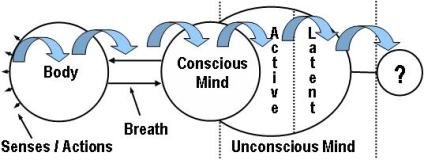From:
http://www.swamij.com/yoga-nidra.htmADDENDUM TO THE YOGA NIDRA ARTICLE ON SWAMIJ.COM
The distortion of the very high practice of Yoga Nidra is so thorough
in the world these days that it seems necessary to make very bright
titles just to have the point noticed.
Throughout this article (and others linked on this page) you will find
explanations that there are THREE levels of consciousness: Waking,
Dreaming, and Deep Sleep (plus the "fourth" which is the transcendent
state known as Turiya). Yoga Nidra is conscious DEEP SLEEP. Deep Sleep
is NOT conscious Dreaming. It is NOT the transition between Waking and
Dreaming. Those are states to explore, but they are NOT Deep Sleep; if
it did have dreams, that would be called Dreaming, and would NOT be
called Deep Sleep.
It is utterly obvious that Deep Sleep does NOT have Dreams to explore.
It should be self-evident that Dreaming and Not-Dreaming (i.e., Deep
Sleep) are two different things. However, books, articles, and CDs
keep telling people that Yoga Nidra is a state of Dreaming, or
transitioning into Dreaming from Waking. This is just not true.
Throughout the ancient writings of the yogis, sages, and rishis there
are explanations of these three states of consciousness. Please don't
just take my word for it. Read the ancient writings, including Vedas,
Upanishads, Bhagavad Gita, and others. You will find these states
talked about over and over, and over again.
Many people are now practicing all sorts of guided imageries in the
name of Yoga Nidra so that they can make money, have better sex, or
manipulate other people. There are CDs out which say Yoga Nidra is for
"this or that" named disease or other specific desire-based purpose.
Yoga Nidra has been made to sound like "The Law of Attraction,"
whereby you fulfill your desires through meditative techniques.
Yoga Nidra was taught by the ancient sages for the purpose of
exploring the deep impressions or samskaras, which drive our actions
or karma. They taught this so that sincere seekers can purify the
deeper aspect of the mind-field, which is accessed in the formless
state of conscious Deep Sleep. If I try to explain the whole process
here in this paragraph, I would have to condense the whole article
here, which can't be done. You must do this exploration yourself. Read
the article. Read the other articles. Read the texts mentioned above.
I'm not writing this here just to complain about other people. The
fact is, that Yoga Nidra is a profoundly useful and deep practice for
enlightenment at this highest level of that word (enlightenment). The
term "Yoga Nidra" has become so watered-down, so distorted that
sincere seekers are not likely to see the extremely high value of
authentic Yoga Nidra. If you read this, research this yourself, and
then do the practices, you'll discover for yourself the very high
value of authentic, traditional Yoga Nidra.
I know that all of this can sound like a "sales pitch." Well, we're
stuck with that. I'm writing this here so that possibly some few
sincere people will move forward with authentic Yoga Nidra. There are
a small handful of people out there who can talk to you about this,
and guide you. I'm not going to recommend any specific names of
people, however. Just explore sincerely; you'll find your way to the
real thing of Yoga Nidra.
While you are here, reading this part of the article, please read
carefully the rest of the article, as well as some of the other
articles about these three levels of consciousness (see levels
articles in the link), particularly the third level, which is the
domain of Deep Sleep. I know it can be a difficult read, but there's
great value in understanding these levels of consciousness and how
Yoga Nidra is used as a tool for higher experience.
Levels articles:
http://www.swamij.com/index-yoga-meditation-levels.htmYoga Nidra article:
http://www.swamij.com/yoga-nidra.htmIn loving service,
Swami Jnaneshvara



